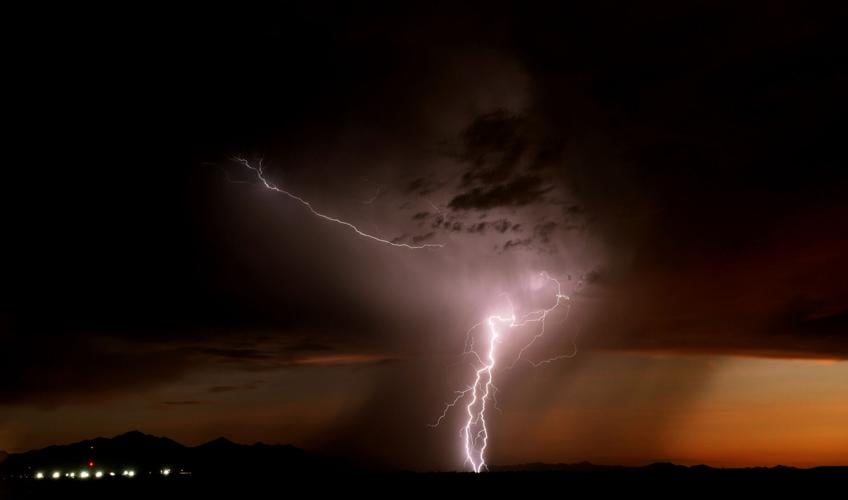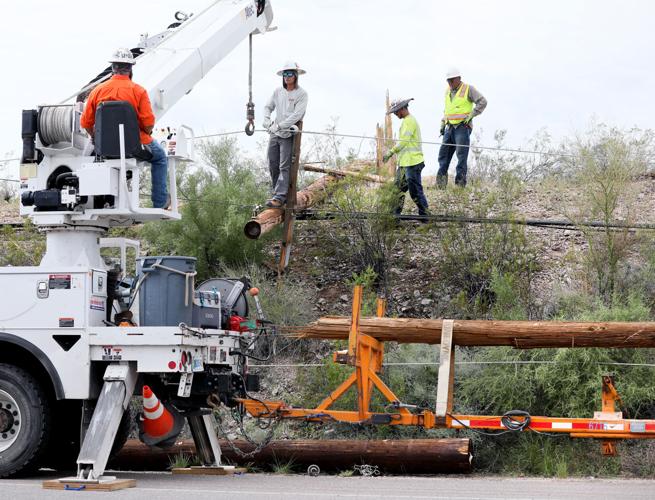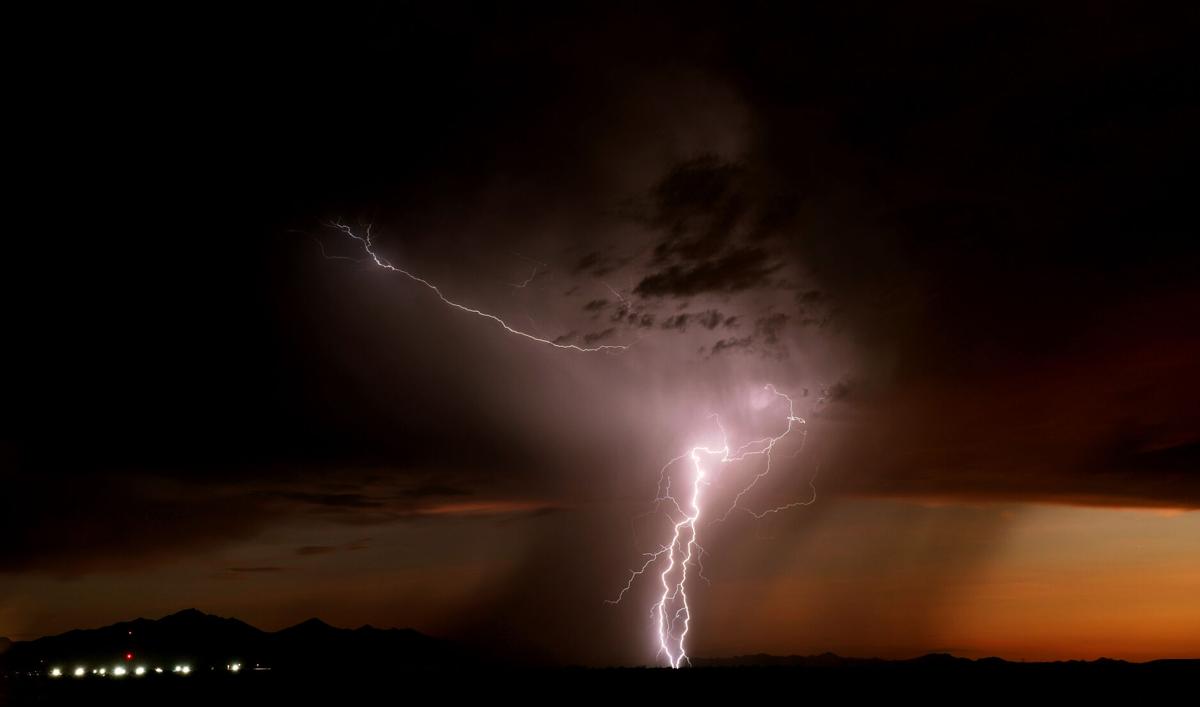Tucson’s 2024 monsoon season so far has been wetter and hotter than normal.
Through Wednesday, Tucson had received 5.43 inches of rain at the airport, where the city keeps its official weather records. That is over two inches above the normal amount expected in the city’s monsoon season — June 15 to September 30, the National Weather Service here noted on Facebook.
The city normally gets 5.69 inches in a typical monsoon season. With about 40% of the season still left, that means Tucson already received about 95% of its typical monsoon rainfall total. Tucson gets an average of 10.61 inches of rain annually.
But other areas in Southern Arizona haven’t been as lucky. For example, Nogales, which received 4.25 inches of rain through Wednesday, about two inches less than normal for the season. Similarly, as of Thursday Safford had received a total 0.29 inches of rain, well below the typical normal 2.14 inches it gets, according to the weather service.
Trace amounts of rain fell at the airport for much of June, until a storm on June 21 dropped 0.35 inches of rainfall, said Gary Zell, a weather service meteorologist.
Zell says that with two distinct rain seasons, it’s important for the region to get as much rain as possible to avoid a drought. But “our drought situation is actually pretty good,” he told the Star Friday.
“There’s still some severe drought in the eastern half of Cochise County, but Pima County, Santa Cruz County and (NWS Tucson’s) portion of Pinal County has been removed from drought status,” Zell said. “So, when you get summer rainfall, not only are you helping the drought situation and the overall water reservoir situation, typically on those days, you have clouds that will cut down at the high temperatures . . . it’ll moderate the temperatures, which moderates evaporation, which also helps with the drought.”
Zell also noted that this monsoon season appears to have resulted in what he views as higher-than-normal storm damage. On Friday night, a storm southwest of Tucson near Sells prompted a tornado warning, though one did not touch down.
“It seems like we’ve had, at least for Tucson, we’ve had some larger damage events associated with the thunderstorms this year,” Zell said. “We always have damage, there’s always severe thunderstorms, but it seems like they’ve impacted more aerial coverage in the city this year compared to normal. We’ve had some big events.”

Workers from Sturgeon Electric Company remove a collapsed electrical pole to replace it along West Speedway near North Greasewood Road after a monsoon storm on Aug. 8 knocked over several poles in the area.
Powerful storms
Through the first seven months of this year, Tucson Electric Power has replaced 128 poles and 79 transformers due to storm damage, said Joe Barrios, a utility spokesman. In last year’s monsoon season, the utility replaced 288 poles and 124 transformers; in 2022, 86 poles and 29 transformers had to be replaced due to monsoon storm damage, Barrios said.
One of the big events this summer’s came on July 2, when a tornado was confirmed on Tucson’s southeast side. Damage was limited.
Zell says that southern Arizona averages of one or two tornadoes every summer, but they’re usually very weak and short-lived.
On July 14, there were two tornado warnings issued when a complex of storms struck the region. Storm damage stretched across the area, including toppled trees, power lines and the roof being ripped off an auto parts store.
The complex brought numerous microbursts throughout the city, with the strongest recorded wind gust reaching 76 miles per hour in the Tucson Mountains.
“Those storms moved across the city. If they had been west of Saguaro National Park West, you wouldn’t have gotten the reports because people don’t live out there,” Zell said. “That’s what strikes me for (this monsoon season) ... we’ve had more than our normal share of damaging events in the city of Tucson.”
From the beginning of June through Thursday, Aug. 15, the Tucson Fire Department has responded to 33 calls for swift-water rescues and 49 stranded vehicle calls, the department says.
The total figure of 82 combined calls is the most since 2021 when there were 47 water rescues and 40 calls for stranded vehicles. But that 2021 figure of 87 is the total through the month of August.
When severe thunderstorms hit the Old Pueblo, Tucson Fire activates its “storm conditions” protocol.
Deputy Chief Barrett Baker says that the activation of this protocol first starts with the department’s alarm room captain at their communications center, who “liaises” with the National Weather Service in Tucson and other local agencies, like Northwest Fire and Golder Ranch Fire District, to anticipate when-and-where a heavy storm is likely to hit.
Based off that information, the department’s “storm conditions” call goes out department-wide, he said. But if a certain area is likely to get it worse, crews from less-impacted areas will move to where they’re needed.
“When we hear ‘storm conditions,’ it’s just knowing that the storm is going to hit somewhere and that we’re ready for it,” he said. “You’re expecting to go on the swift-water rescue type of calls... the stranded motorist calls, you’re expecting to do a little bit more of the water-related rescues.”
There are some operational changes undergone when the protocol is activated, he said. Ladder trucks will go out of service for medical calls and prioritize service for more rescue-related calls, while crews will also change out their turnout” gear − the quintessential firefighter garb − for T-shirts, shorts and a buoyancy vest to be more effective when it comes to water rescue calls, he said.
“So if we get the stranded motorists, if we get the stranded swift-water rescues... (the ladder trucks are) going to be able to get dispatched to something like that much quicker because they wouldn’t necessarily be on a medical call,” Baker told the Star. “Out turnouts protect us from fires, but that would be obviously detrimental to wear if we were around a wash and got swept in.”

A driver sits in a flooded out vehicle in the middle of Country Club Road just south of Ft. Lowell Road in the midst of a monsoon storm on July 25. Several vehicles stalled out in the waist high runoff on Country Club at Presidio Road in the midst of a monsoon rain. Emergency personnel were scrambling for a couple of hours to calls throughout the city.
Additionally, the department is beginning to coordinate better with the weather service when harsh conditions hit, Deputy Chief Gregg Hoffman said.
The goal is for weather service personnel to go to the Tucson Fire command center to track storms in real-time, and assist in the allocation of crews and resources, he said.
The joint work is still in development, Hoffman said, but that by next summer it will be an official aspect of Tucson Fire’s storm activity response.
Hotter than normalLast year brought one the hottest, driest monsoon seasons on record, and after an unusually wet winter, forecasters suggested Tucsonans should’ve prepared for another hotter-and-drier summer than normal.
While the above-average rain has come as a surprise, forecasters were correct about the heat, according to historical weather data from the National Weather Service in Tucson.
Based on historical weather data dating back to 1895, the weather service says that an average Old Pueblo summer gets its first 100-degree day on May 24, its first 105-degree day on June 11 and its first 110-plus-degree day on June 28.
While this year’s first 100-degree day came three days past the historical average − May 27 − Tucson recorded its first 105-degree day on June 5 − six days before the historical average. The city saw its first 110-degree day on June 20 − eight days before it normally comes.
Dating back to 1895, Tucson normally has 68 days reach at least 100 degrees between May and October, according to historical weather service data.
The city surpassed this 68-day mark by Aug. 6. As of Friday, there have been 72 such days this monsoon season, Zell said.
Similarly, the average number of days between May and September of at least 105 degrees is 26. Aug. 4 marked the 35th day Tucson reached at least 105 degrees for the period, Zell said.
According to that same historical data, Tucson usually sees just two days reach 110 degrees through that same four-month span. The city got its its sixth 110-degree day on July 11, Zell said.







